Antherea yamamai
When I went into the soap/silkworm room to check on the cocoons, I found this guy hanging his still-damp wings. It’s a Yamamai or Tensan silkmoth, originally from Japan.
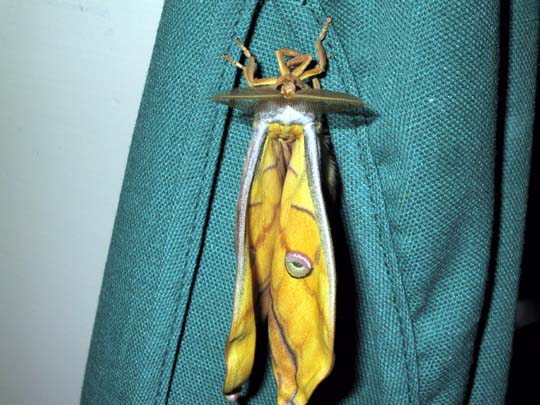
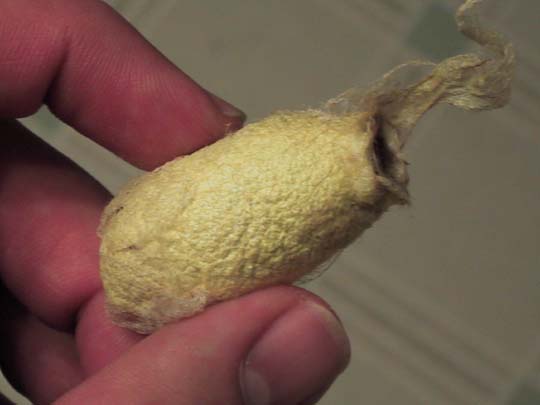
This is the cocoon he came out of. This moth is related to the Tussah moths, and makes a very similar silk – except that it’s a pale yellow-green. As with the other Tussah moths, the color is actually ingrained in the fiber – so THIS won’t come out! I haven’t worked up any of the silk yet, but I’m looking forward to it.
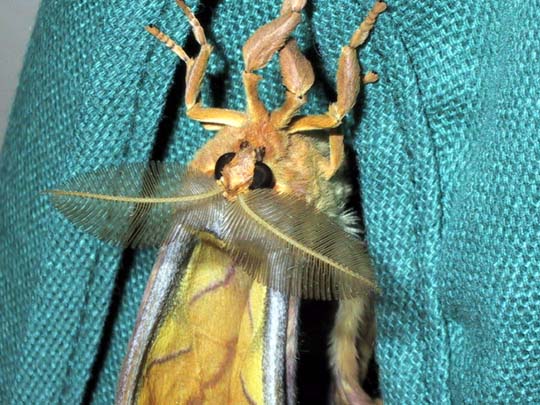
Here you can see the big bushy antennae that let you know he’s a male.
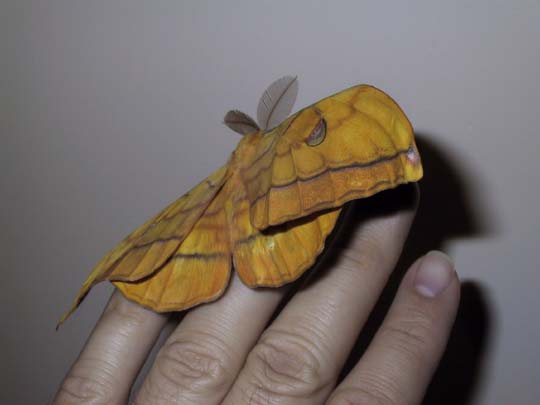
This is a very wiggly moth. Unlike a lot of the other Tussah moths, this one won’t sit still and be photographed – he keeps walking over my hand.
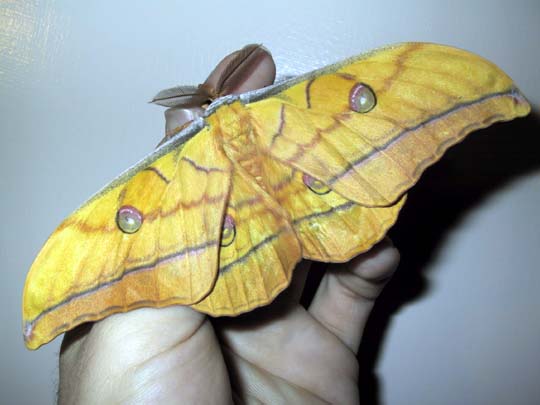
He’s really beautiful. This is one of my favorite moths so far – I love the color.

he’s absolutely lovely.
i can hardly wait to see the fiber 🙂
i am agasp (no such word i think) and overcome by that moth.
i cannot believe the absolute beauty. lucky you!
you are wise and right, obviously, for such magic is earned. i think so.
wow. i’m lucky, too, for seeing it.
thank you!
when i first saw it, the first photo, i thought it was jewelry.
Hee. Yes – the colors would make a pretty enamel.
He’s just beautiful.
I always thought the moths destroyed the silk when the exited the cocoon, yet the cocoon in the shot is perfect except for the exit hole at the end. Would that still be useable – for silk caps, or something like that?
is it ok for me to link to this post in a LJ entry?
Sure!
It’s still useable for caps, hankies, and combed fiber. What it’s “ruined” for, is reeling – the fiber is no longer a single continuous length.
I’m glad I’m not the only one who thought that. [*chuckle*]
How interesting – that makes me look at it in a whole new light.
Silk moths are all so amazingly pretty! Thanks a bunch for posting photos of this little guy for me to look at and go ooooOOOoooh (and for reminding me I’m running a bit short on your lovely soap).
Beauteous!
My fav part of last year’s silkworm moth raising adventure with was taking the newly emergent female Cercropias outside in a birdcage to attract wild males for breeding. Worked like a charm and he did get second generation eggs.
Wow, he’s beautiful, I love the eye spots
My mouth is hanging wide open.
What a gift from the universe!
d.
wow!
so gorgeous 🙂
Very pretty! What an amazing color.
I didn’t take the shot with this species, but they’re translucent, like the Tussah moths – this is a photo of a female Tussah moth with back-lighting.
Re: Beauteous!
I love having them fly in. It’s very magical – especially the one night when I had six wild giants fluttering around my head in the light of the full moon.
Wow, thats awesome.
His antenae look like fern leaves. He’s big too. The last picture with him on your hand is shocking. When I think of moths I still think of those tiny light brown things that swarm the porch light. Not anything like this guy. He’s beautiful. Do they still like light at this size?
WOW!
So pretty!
He’s got five inches or more across the wings. He didn’t want to be still for me to take a shot with the ruler. Yes, they still go to lights; it’s been a problem with wild populations, because they go “ooh, pretty!” and get lost on their breeding flights.
That is stunning – what a gift of nature.
shellac! just kidding!
🙂
He is just gorgeous! Where do you keep your moths? Do you have room set up for them or are they in the garage? Do you have to have permits to keep them?
they live in a terrarium in my soapmaking room.
I haven’t actually investigated the permit issue in depth. I’m always careful with exotics, keeping them inside, etc.
Wow, even more amazing. Moths are so cool.
That gorgeous creature at first looked like some really glamorous piece of post-modern jewellery but then nature proofs nothing man could make could be so lovely.
x g
Ok I’m feeling kinda dumb tonite. I never really thought about it – I just look at your pictures and enjoy – but where do you get whatever you turn into the thread…its not made of the moth, right? Its something he made?
The cocoons are made of silk. The caterpillar secretes the silk from a gland in its chin, spinning the cocoon before changing into a pupa and then into a moth.
I work with the cocoon to derive the silk.
Ok so I read back through again and saw it can’t be “reeled” but could be caps, hankies and combed fiber. How do you get reeled fiber then?
How long do the moths live after they hatch? Do you just open the door and let them out or?
Reeled fiber comes from whole cocoons which are stifled (killed) with heat, steam, or sunshine. I use the oven.
The moths usually live less than a week; it partially depends on whether they breed, because that takes a lot of energy. They have no mouths, so they cannot eat or drink. Some of the native-to-here species I will release, like Polyphemus, but the exotics have to stay in the house because they’re not from around here.
Gotcha! Is one that hatched one of the ones you were trying to hatch early?
Nah… those are eggs that I’m trying to hatch early, and they’re for Bombyx mori, the China silk moth. If those hatch as planned later this week, what I’ll get is caterpillars.
Michael
And then the caterpillars will make moths and cocoons?
The other way around… the caterpillars will spin cocoons, and inside those cocoons they will become moths. Then, they hatch out, breed, lay eggs, which hatch into caterpillars, etc., etc.
Thanks for the lesson! =)
they have no mouths?
no moth does? i find that devastating.
None of the Saturniid moths do. Some other kinds do – like the hummingbird moths, which visit night flowers. But the big silkmoths, wild and domesticated, are mouthless.
One author said they’re like flowers – the plant spends most of its time in the vegetative state, and only makes the flower to last for a short time to reproduce.
q’s from the peanut gallery.
yeah, i’m poking around websites about it. oaken, do some moths then, your people, do they not have the nose/tongue thing either? (not even a drop of water? oh my).
and, of all your guys, what percent hatch out and what percent are smothered?
Re: q’s from the peanut gallery.
Not even a drop of water. That’s the main reason they only live five to seven days – they run out of juice, and burn up all their fat stores.
As far as hatch/stifle percentages – it really just depends. With the Bombyx, I usually hatch about a dozen from any batch, maybe as many as 20, and then the rest are stifled to use for silk. So the percentages will be a lot different if there are 1000, than if there are 150. It’s kind of like seed potatoes – you plant a few of the best ones, and use the rest.
I haven’t yet stifled any of the giant moths. Partly because they are just so beautiful, but also partly because I haven’t had enough to be able to ensure the success of the next generation in addition to having some to reel silk from. I do plan to, in the future, reel silk from at least a couple of them.
I just discovered your LJ…
… through a link from another LJ…. anyway, I was wondering how difficult it is to raise the moths. Where do you get food? Where do you get the MOTHS? I was interested in doing a research on the subject with my own experiment in raising them and working with the silk. Any suggestions/help/info would be great!
Oh and I’d like to add you to my friends list if that’s alright with you.
Re: I just discovered your LJ…
Which moths? The Bombyx silkmoths are very simple to raise. They’re kind of like guppies or hamsters – if you can provide a few basics, lots of mulberry, clean tank, steady temperature, they will produce very vigorously. Some of the others, particularly the wild types, are more challenging, requiring a more natualistic environment, and things like the texture of the leaves and the moisture of them becomes more of an issue. I get food from trees in my suburban yard; fortunately, there was a big mulberry growing here when I moved in. I have gotten moths in either cocoons or in eggs from a variety of sources; I share moths a lot. I also run a Yahoo group called CatHerders (cat = caterpillar) and lots of us trade eggs and such back and forth. I would suggest joining that, if you want to learn more. Also, my website at http://www.wormspit.com has a lot more of my adventures.
And add away! I’ll add you back. Just be aware that the only thing I regularly use my friends-only filter for is my dreamwork, which can get a little weird/disturbing… it’s always behind a cut-tag, so you have the option not to read it.
Here via…golly, these photos are just incredible. Thanks so much for sharing.
You run an interesting LJ, sir. 🙂
🙂 Thanks!